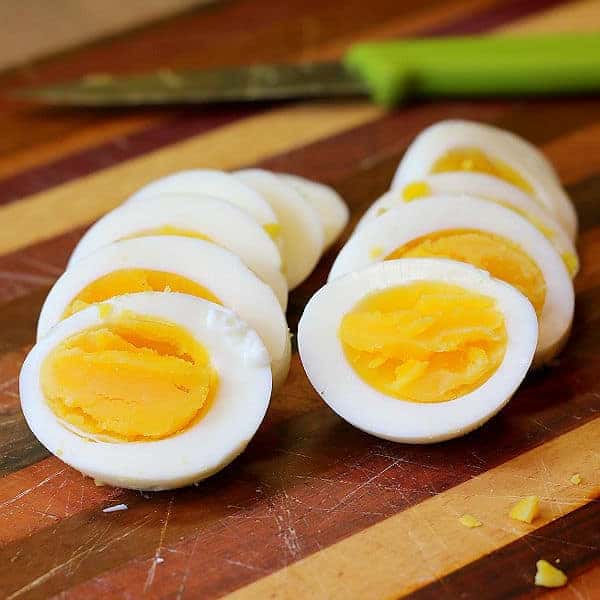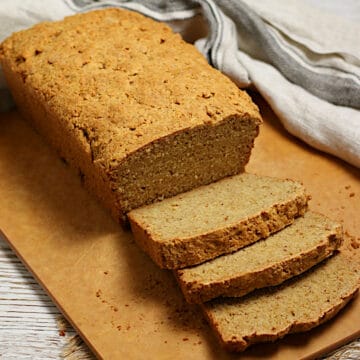Perfect Stovetop Hard-Boiled Eggs
These Perfect Stovetop Hard-Boiled Eggs turn out perfectly cooked every time. Great for egg salad, deviled eggs, or just to eat!

No matter how many delicious and extravagant foods I make at home, whether savory or sweet, nothing gets my husband raving about my cooking skills like my Perfect Stovetop Hard-Boiled Eggs. It is pretty much what earned me the Domestic Dreamboat nickname around our house.
So why exactly does Hubby rave about my hard-boiled eggs anyway? I mean, aren't hard-boiled eggs one of the easiest things ever to make? And aren't all hard-boiled eggs the same anyway?
Well, as it turns out, not exactly. I'm sure you've all had a bad hard-boiled egg. You know the ones - slightly rubbery with a greenish-black ring around the yolk? They aren't unsafe to eat, but they do indicate an overcooked egg.
On the other side of the spectrum, you may bite into a hard-boiled egg, at least expecting it to be hard-boiled, only to have the yolk dripping down your chin. Again, not bad if it was intended to be that way, but it doesn't exactly work well for deviled eggs or an egg salad sandwich.

To get the perfect hard-boiled eggs, you need to think a little bit about science. Specifically, you need to get the timing and temperature right.
I learned how to make hard-boiled eggs the right way in my Food Fundamentals and Quality course at University. What a great class - I learned a lot about how different ingredients and cooking methods affect foods in different ways. Perhaps I'll have to go back to school for food science someday.

How to make Perfect Stovetop Hard-Boiled Eggs:
You don't need any special equipment or ingredients to make stovetop hard-boiled eggs. If you have eggs in your fridge, you probably already have everything you need.
To make Perfect Stovetop Hard-Boiled Eggs you will need:
- eggs (as few or as many as you want to boil)
- cold water
- a saucepan that fits the number of eggs you want to boil and a lid that fits the saucepan
- ice
One thing you should know when making hard-boiled eggs is that the older the eggs (like just before the best before date, or even slightly after), the easier your boiled eggs will be to peel.
So if you're deciding between a freshly purchased carton of eggs and an older one, it's okay (maybe even better) to use the older ones.

You can make as many or as few boiled eggs at once as you want. But the number of eggs you decide to make will affect your pot selection.
Choose a pot that is large enough to accommodate the number of eggs you are boiling in a single layer. Make sure the pot has a lid that fits it. Then fill the pot with enough COLD water to almost cover the eggs.
When it comes time to turn on the stove, don't choose maximum heat, especially if your stovetop heats up quickly (like induction or gas). If you bring the water to a boil too quickly, the shells may crack and you'll wind up with watery eggs.
Instead, choose a medium-high or high-medium-high heat. I use 8, where my maximum is 10.
Cover the pot and allow the water to come to a boil. As soon as the water starts to boil, turn the heat down to low and set the timer for 9 minutes.
While you're waiting for the timer to go off, fill a bowl with ice water to cool the eggs. If you let the eggs boil too long, or let them sit in the hot water too long, or don't cool the eggs right away you will get the dreaded black ring around the yolk.

Let the eggs sit in the ice bath until they're cooled (or, if you plan to eat them right away, go ahead and peel them as soon as they're cool enough to handle).
To peel the eggs, give them a gentle tap on the counter to crack the shell, then firmly roll them back and forth across the counter to crack the shell all around.
Gently peel the shell completely off, and if needed, give them a quick rinse and dry to remove any shell pieces. Boiled eggs are great to keep on hand in the fridge for a quick high protein snack, or to add to salads or make quick egg salad sandwiches from.

How to use Perfect Stovetop Hard-Boiled Eggs:
Perfect Stovetop Hard-Boiled Eggs Nutrition Notes:
Hard-boiled eggs are a nutritious, low-fat, high-protein snack or meal choice.
While eating too many eggs was discouraged several years ago due to their cholesterol content, nutrition experts now acknowledge that dietary sources of cholesterol don't affect cholesterol levels in our bodies as much as previously thought.
Perfect Stovetop Hard-Boiled Eggs

Ingredients
Instructions
- Place eggs in a saucepan large enough to accommodate the number of eggs you are boiling, in a single layer.
- Cover eggs almost completely with COLD water. Cover saucepan and place on the stove over medium high-high heat (I use setting 8, where 10 is maximum).
- When the water comes to a boil, reduce heat to low and set the timer for 9 minutes. Do not uncover the saucepan.
- While you are waiting for the timer to go off, fill a large boil with ice water.
- As soon as the timer goes off, drain the hot water from the pot and transfer the eggs to the ice water. If you are eating any of the eggs immediately, do so while still warm. Otherwise, keep the eggs in the ice water until completely cooled, changing water if needed. Refrigerate boiled eggs until ready to use.
- To peel: Tap each egg gently on a flat service to crack. Firmly roll the egg back and forth in order to crack the egg all around. Gently peel the shell from the egg, rinsing the egg to remove any small shell particles as needed.
Nutrition
Notes
Tried this recipe?
Please consider Leaving a Review!






